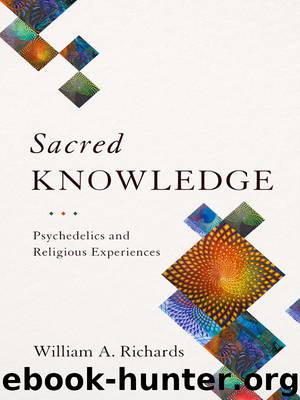Sacred Knowledge by William A. Richards

Author:William A. Richards
Language: eng
Format: epub
Tags: MED105020, Medical/Psychiatry/Psychopharmacology, REL062000, Religion/Spirituality
Publisher: Columbia University Press
Published: 2015-12-08T05:00:00+00:00
PSYCHOLYTIC, PSYCHEDELIC, AND PSYCHODELYTIC THERAPY
Similarly, during the action of entheogens, there are usually a variety of states of consciousness, some of which may focus on personal emotions and memories without explicit religious content. When entheogens have been administered in attempts to deepen and accelerate psychotherapy, often in repetitive low dosages, the content of sessions often includes the reliving of traumatic childhood experiences and the sorting out of emotions of guilt, fear, anger, and grief. Here, instead of the presence of the minister and congregation, the acceptance and steady presence of the psychotherapist or guide provide the interpersonal grounding requisite for healing. Especially in Europe, psychedelic substances were used in mental health clinics in this manner, often labeled as psycholytic (mind-releasing) therapy.
A Dutch psychiatrist, G. W. Arendsen-Hein, integrated the psycholytic approach with the higher-dosage psychedelic form of treatment in a clinic known as Veluweland that he designed in Ederveen, a suburb of Amsterdam. There he administered a series of low-dose sessions, once or twice a week, to his patients (registered as “guests”) in small rooms until he judged that they had adequately addressed their personal, psychodynamic issues. Then he would admit them into a beautifully designed, significantly larger room, often for a single high-dose session, in hopes of facilitating a mystical type of experience. As I recall his psychedelic room, the green carpet merged with the green grass outside a large picture window, where one might well see swans gliding on a small pond. Within the room were comfortable furnishings, a fireplace, and a sculpture of the Buddha. Arendsen-Hein posited that the most effective treatment included both sessions that focused on what Carl Jung called the “personal unconscious” and a mystical encounter with the “collective unconscious” that was believed to provide a profound sense of integration and a deeper feeling of being at home in the world. Unfortunately, like most of the clinicians who used psychedelic substances with their patients in the 1960s, Arendsen-Hein had neither the resources nor the inclination to pursue carefully designed research protocols with control groups that today are expected in the scientific community in order to establish the effectiveness of a new treatment modality.
In the use of psychedelic substances in psychotherapy, there are clearly two potential trajectories, both of which appear to work well. In one, the person gradually works through personal psychodynamic experiences en route to the realm of transcendental forms of consciousness. This approach is most congruent with psychoanalytic approaches to treatment. In the other, which uses higher dosage, it may be possible for some people to experience mystical and archetypal forms of consciousness in an initial session, sometimes sort of making an end-run around any personal conflicts that might eventually need to be addressed. Then, in the weeks and months afterward, in light of the memory of mystical consciousness, one addresses the issues of personal, psychodynamic import. This approach appears to work especially well with people suffering from addictive disorders, who have lived with an abundance of low self-worth, fueled by repetitive experiences of failure and shame.
Download
This site does not store any files on its server. We only index and link to content provided by other sites. Please contact the content providers to delete copyright contents if any and email us, we'll remove relevant links or contents immediately.
| Administration & Medicine Economics | Allied Health Professions |
| Basic Sciences | Dentistry |
| History | Medical Informatics |
| Medicine | Nursing |
| Pharmacology | Psychology |
| Research | Veterinary Medicine |
The Art of Thinking Clearly by Rolf Dobelli(9929)
The 5 Love Languages: The Secret to Love That Lasts by Gary Chapman(9292)
Mindhunter: Inside the FBI's Elite Serial Crime Unit by John E. Douglas & Mark Olshaker(8708)
Becoming Supernatural by Dr. Joe Dispenza(7845)
The Road Less Traveled by M. Scott Peck(7284)
Nudge - Improving Decisions about Health, Wealth, and Happiness by Thaler Sunstein(7255)
Mastermind: How to Think Like Sherlock Holmes by Maria Konnikova(6942)
Enlightenment Now: The Case for Reason, Science, Humanism, and Progress by Steven Pinker(6878)
Win Bigly by Scott Adams(6831)
The Way of Zen by Alan W. Watts(6292)
Factfulness: Ten Reasons We're Wrong About the World – and Why Things Are Better Than You Think by Hans Rosling(4497)
The State of Affairs by Esther Perel(4491)
Gerald's Game by Stephen King(4379)
Man's Search for Meaning by Viktor Frankl(4295)
The Confidence Code by Katty Kay(4041)
Thinking in Bets by Annie Duke(4007)
The Worm at the Core by Sheldon Solomon(3327)
Hidden Persuasion: 33 psychological influence techniques in advertising by Marc Andrews & Matthijs van Leeuwen & Rick van Baaren(3302)
Enlightenment Now by Steven Pinker(3276)
